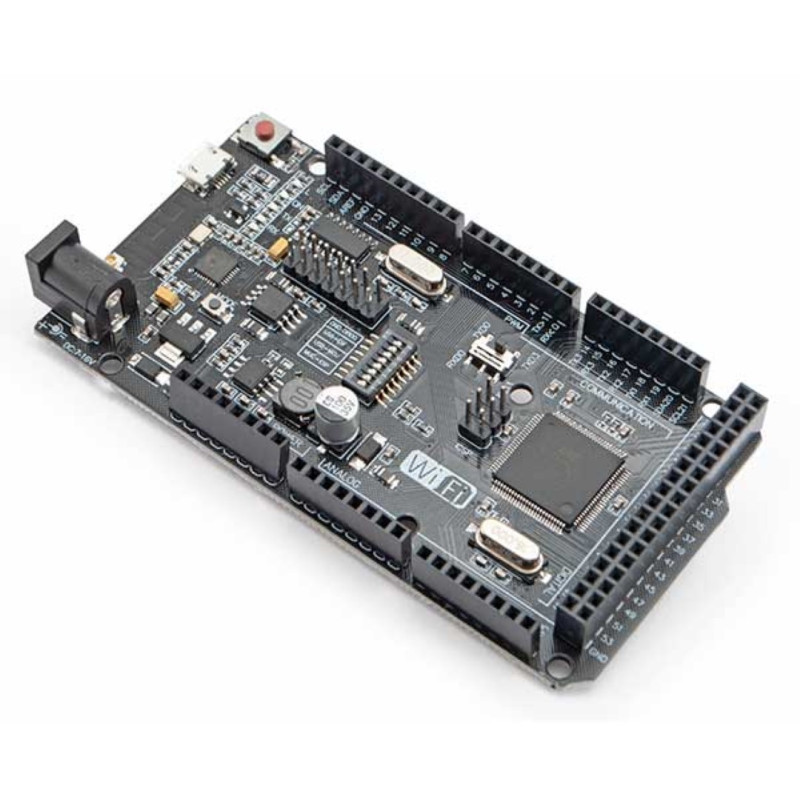








FISHMEGAWIFI is the ideal solution for your projects that require power, versatility and Wi-Fi connectivity
 Secure Payments
Secure Payments
Pay safely with Credit Card, PayPal, Amazon Pay or Bank Transfer
 Fast Shipping
Fast Shipping
We ship across Europe and worldwide with UPS, DHL and DPD
 30-Day Easy Return
30-Day Easy Return
You have 30 days from delivery to return the product if you're not satisfied
FISHMEGAWIFI is the ideal solution for your projects that require power, versatility and Wi-Fi connectivity. This board combines the ATmega2560 microcontroller and the ESP8266 SoC (System-On-a-Chip) Wi-Fi module, offering a wide range of features that make it indispensable for electronics enthusiasts and industry experts.
With two functional modules integrated on the board, you can make them operate independently or synchronized, each with their own pin interfaces. This versatility provides an extremely flexible development environment, suitable for a wide range of projects.
The combination of the two modules offers a more powerful and versatile development environment for new projects, enabling advanced connectivity and management of complex wireless functionality. Furthermore, thanks to the presence of a female USB socket on the board, users can easily update the firmware via the USB port, making the development process more convenient and accessible.
With 54 digital inputs/outputs, of which 14 can be used as PWM outputs, and 16 analog inputs, the FISHMEGAWIFI board offers extensive connectivity and control capability. This allows you to connect numerous sensors, actuators and external devices to create complex, interactive designs.
The board is also equipped with 4 UART ports (serial ports) for communicating with other devices, ensuring hassle-free connectivity. Thanks to the 16 MHz crystal oscillator, high timing precision is achieved.
The built-in Wi-Fi connection simplifies interfacing with wireless networks, allowing wireless communication with other devices and access to cloud-based services. Alternatively, it is possible to power the board via an AC/DC transformer or a battery for autonomous operation.
With 256kB Flash memory (of which 8kB is used by the bootloader) and 8kB SRAM, you will have enough space for your code and data. Additionally, the card is equipped with a 4kB EEPROM for permanent information storage.
USEFUL LINKS MANUAL
Main features
Consists of two main modules: This development board combines the Mega R3 ATmega2560 and Wi-Fi ESP8266 modules into one. This integration offers a more flexible and efficient environment for developing new projects.
Independent or Combined Operation: Both modules on the board can work independently or simultaneously, each with their own pin interfaces. This allows for versatile use in a wide range of projects.
Easy to Use USB Interface: The board is equipped with a Micro USB socket that allows users to update the firmware via the USB port, simplifying the development process.
High Performance: With built-in powerful Mega R3 ATmega2560 and ESP8266 WiFi modules, this board offers superior performance and functionality for a variety of projects.
Versatile Use: This board is ideal for hobbyists, engineers and students who need a reliable and efficient development board for a wide range of applications, including robotics, IoT, home automation and more.
Technical features
· Microcontroller: ATmega2560
· IC: Wi-Fi – ESP8266
· USB-TTL converter: CH340G
· Operating levels: 5V
· Supply voltage (recommended): 9 to 12 V
· Supply voltage (limits): 7-16V
· Digital inputs/outputs: 54 (of which 14 can be used as PWM outputs)
· Analog inputs: 16
· DC current per I/O pin: 40 mA
· DC current per 3.3V pin: 50mA
· Flash memory: 256 kB (of which 8 kB used by the bootloader)
· SRAM: 8kB
· EEPROM: 4kB
· Clock: 16 MHz
· Dimensions: 10.5×5.3cm